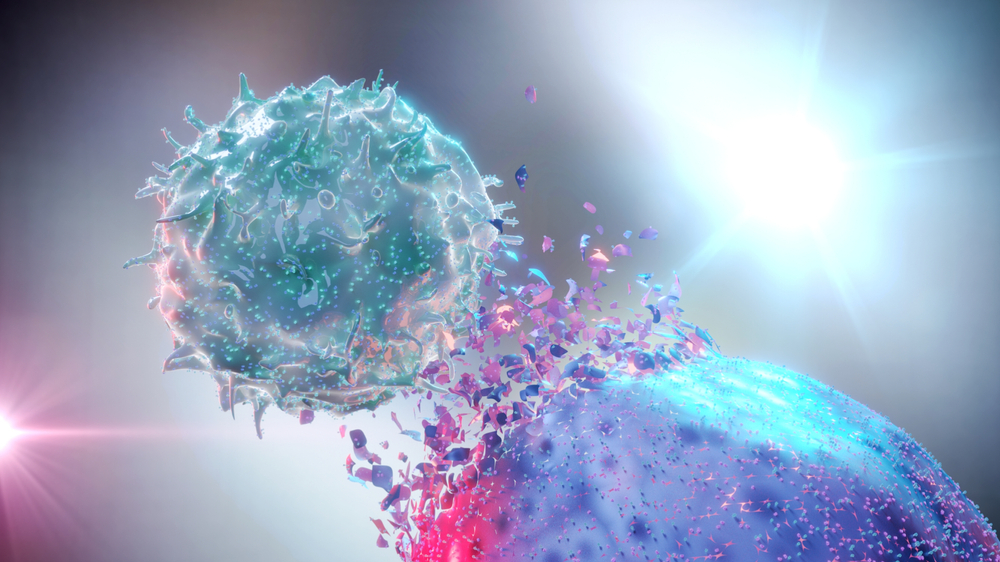Natural killer cells in glioblastoma therapy
Posted on 9th December 2022 by Davide E. De Dominicis

Introduction
Glioblastoma, as epidemiological studies show, is the most common type of brain tumour, with an incidence rate of 5.26 per 100,000 population, and fewer than 5% of patients surviving 5 years after diagnosis. Healthcare professionals, therefore, are deeply invested in finding more effective therapies.
It is widely known that one basis for a tumour’s growth process is represented by its microenvironment. Components of the immune system play an important role in disturbing it, as hundreds of studies recognize. For this reason, physicians have begun looking to immunotherapies as promising strategies to fight against broad categories of oncological diseases.
In my previous blog, Biomarkers for better diagnosis: the case of mild cognitive impairment, it was observed that today’s modern neuroscience continue to face multiple challenges due to diseases that result in fatal outcomes. Some fundamental aspects like aetiology, pathogenesis and effective therapeutic strategies, are in fact far from being characterized. Exploring the latest advances in other medical fields (that can revolutionize the debate around some diseases) and their connections with the world of neuroscience, with a multidisciplinary and evidence-based approach, could achieve new progress and present a way to shape tomorrow’s neurology.
For these reasons, I am presenting a summary of new evidence on the potential of a therapeutic strategy born at the crossroad between neurology, immunology and oncology. The systematic review summarized here focuses in particular on the role natural killer (NK) cells (a cytotype that acts as a bridge between innate and adaptive immunity) could play in novel hypothesis of immunotherapy against glioblastoma.
State-of-the-art therapies: a matter of efficacy
Even if regulatory bodies approved strategies for using NK cells in glioblastoma therapy, none of them have proved to be highly effective, to date. Some protocols that are still concluding Phase II/III studies are rapidly coming to the same conclusions. To know more about Phase II and III studies, have a look at this blog: An introduction to different types of study design.
Physicians still consider ‘maximal safe resection’ and subsequent adjuvant therapy as standard strategies to use in a therapeutic schedule. Unfortunately, these procedures lack definitive evidence of effectiveness. Use of alkylating agents, such as temozolomide, in post-operative follow-up can only delay recurrence without being capable of complete prevention of such inauspicious events. Radiotherapy and targeted drugs like bevacizumab do not contribute to eliminate the main factor for tumour resistance and proliferation – its complex microenvironment.
Recent protocols already contemplate using immunotherapies like CAR-T cells, immune checkpoint inhibitors and vaccine therapy, followed also by promising oncolytic virus therapies. Their main point of weakness is represented by inconclusive results about safety and efficacy in glioblastoma studies. Despite everything, they prove effective in treating other oncologic malignancies.
NK Cells and Glioblastoma: applications and perspectives
NK cells play an important role in the immune system because of their ability to kill cells that are infected by viruses or other intracellular pathogenic agents. Because T cells cannot recognize pathogens in the absence of surface antigens, NK cells could contribute by recognising and killing tumour cells.
NK cells’ activity strongly depends on the type of cytokines that are present in a particular microenvironment. TGF-β and interleukin 10 (IL-10) are two immunosuppressive cytokines that neoplastic cells produce to depress NK cells’ functions. Some studies focus on the possibility of reverting suppression by modulating NK cells’ activity using interleukin 2 (IL-2). It is possible to achieve immunomodulation by targeting NK cells with novel pharmacological treatments too.
Cilengitide is an example of a drug used recently to facilitate glioblastoma stem cells’ lysis by NK cells.
Biotechnologies and open questions for NK cells-based therapy
Because of the necessity of more realistic scenarios in vitro, recent studies used organoids or 3D bioprinting. These technologies have obtained accurate representation of what happens in the tumour’s microenvironment in response to new therapies. As shown, therefore, modern technologies are crucial in obtaining a better understanding of NK cells’ activity in glioblastoma. The CRISPR-Cas9 system, a complex (but nowadays essential) gene editing method, could give an extremely important contribution in developing new immunotherapies. Thanks to this technique, researchers now have broad possibilities in gene editing and reprogramming. They may be able to enforce NK cells’ anti-tumour functions by knocking out specific receptors that glioblastoma cells could potentially use to suppress the immune system.
Researchers show that there are still many open questions that need to be clarified with further studies. For example, there is a lack of evidence available about how NK cells are regulated in the glioblastoma microenvironment. Giving an answer to this question is important to achieve effectiveness in the therapy.
The pathway to ensure a safe, affordable and effective use of novel immunotherapies against glioblastoma is particularly long. Scientists have, first of all, to explain all the unclear points in NK cells’ functionality. They can then consider this cytotype as a promising option in fighting tumours and hopefully lead to an increase in life expectancy.
References
The review
Wang, M., Zhou, Z., Wang, X., Zhang, C., & Jiang, X. (2022). Natural killer cell awakening: unleash cancer-immunity cycle against glioblastoma. Cell death & disease, 13(7), 588. https://doi.org/10.1038/s41419-022-05041-y
Other references
Omuro, A., & DeAngelis, L. M. (2013). Glioblastoma and other malignant gliomas: a clinical review. JAMA, 310(17), 1842–1850. https://doi.org/10.1001/jama.2013.280319
Delgado-López, P. D., & Corrales-García, E. M. (2016). Survival in glioblastoma: a review on the impact of treatment modalities. Clinical & translational oncology : official publication of the Federation of Spanish Oncology Societies and of the National Cancer Institute of Mexico, 18(11), 1062–1071. https://doi.org/10.1007/s12094-016-1497-x



